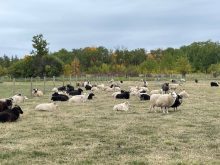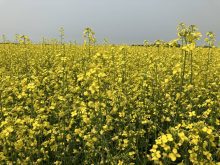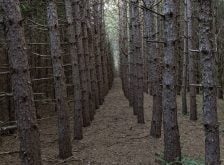Where did such a destructive disease come from? Verticillium stripe was first reported in Manitoba in 2014, some 10 years ago. The fungus, Verticillium longisporum, has now been confirmed present in six provinces: British Columbia, Alberta, Saskatchewan, Manitoba, Ontario and Quebec. In a survey in 2023 across Manitoba, verticillium stripe was found in 38 per cent of canola crops surveyed. How did this disease, prevalent in European canola (rapeseed) crops, cross the Atlantic?
Read Also

Gentle treatments for pain in the neck
Heading toward year-end, people unknowingly tense up against the cold and busyness, causing neck pain that can often be treated with appropriate support and gentle mobility, athletic therapist Kathlyn Hossack says.
It is likely this disease could have been present for many years in both Canada and the U.S. Verticillium stripe is a disease of very many cruciferous crops such as cabbage, cauliflower, broccoli, radish and wild mustard among others. It was first discovered on Brussels sprouts in the U.K. in 1957 and on horseradish in Germany in 1961, when it was initially called Verticillium dahliae var. longisporum, but later became V. longisporum.
Unfortunately, like most disease organisms, it comes in several strains or types. There are hybrids of V. longisporum, classified as A1/D1, A1/D2 and A1/D3 and perhaps others. I first thought, since horseradish is widely grown in Canada and propagated by tuberous roots, that this may be the culprit that introduced V. longisporum on canola. Not so, since the fungal strains found on canola are A1/D1 and the strains found on horseradish are A1/D2. There goes my theory.

It is likely the stripe disease came to Western Canada via cabbage, broccoli or other family seedlings from Eastern Canada, and Ontario in particular with its wide range of Chinese and European brassicas. North Dakota found its first verticillium stripe disease on canola in 2021. In that state they took many diagnostic procedures to absolutely confirm they were dealing with V. longisporum. This could mean this fungus (microsclerotia) may not be spread by birds, such as ducks or geese, as theorized; it affirms the likely spread is by mud or crop residue on farm equipment from field to field.
The Canadian Food Inspection Agency (CFIA) considered making V. longisporum a quarantine pest, but surveys following the 2014 discovery of this disease banished the thought. It was found in all six central and western provinces and was also known to be present in many areas in the U.S.
Verticillium stripe is a soil-borne disease, similar in some ways to clubroot. Tiny black, pepperlike sclerotia are widespread on infected canola stem tissue. These black tiny propagules can persist in the soil for up to 10 years, perhaps longer. It’s called “stripe” since the fungus really damages the outer parts of the canola stems and they appear very obviously striped. You can actually peel back the stems and see the black stippling — quite like the tiny black pycnidia of the blackleg fungus.
If you have any recognition doubts, any of the seed testing laboratories in Western Canada can do a positive DNA diagnosis in short order.
READ MORE: Don’t be a silly one, scout for verticillium
The verticillium stripe fungus is said to cause losses in Europe of 10 to 50 per cent of winter canola crops. Perhaps damage will be less on our shorter spring crops. Soil temperatures in the 60s (F) seem to favour disease development, and field damage in Europe on their rapeseed usually occurs in patches. The disease goes through only one cycle a year.
In Manitoba it appears almost 40 per cent or more canola crops were found to be infected with this disease in 2022. This could mean the disease may have been present there well prior to 2014 — as was the case with clubroot, which was found in Alberta in 2003 but was likely present much earlier in the Edmonton area.


Detection
I will avoid a detailed description of verticillium stripe since there are lots of excellent descriptions and photographs of symptoms provided by Manitoba and Canola Council publications. Check out “How to identify verticillium stripe” on the council’s Canola Watch website.
“A stitch in time saves nine.” If canola growers can slow down or perhaps control the spread of this disease, it will buy time for plant breeders to work on and hopefully come up with stripe-resistant or -tolerant canola crops.
So, verticillium wilt is here to stay. What can we do to keep it off our canola cropland — or to keep it under control if it’s been diagnosed on one or more of your canola fields?
Prevention
Preventing verticillium stripe from getting onto your cropland would be very similar to clubroot or pea root rot control. Your biggest disease spreaders are:
- Farm equipment, going from a known infested field to a field that has never shown up with this disease. We know it’s equipment, since in the case of clubroot, for example, the disease invariably shows up first on the field entrance.
- Custom seeding equipment, going from farm to farm without cleaning and hosing down mud on the seeders, fertilizer wagons and herbicide application equipment.
- Bale wagons that move from muddy field to muddy field in the fall or early spring. Verticillium stripe spores last like clubroot spores, for up to 10 years or more.
- Under very dry conditions, the verticillium stripe’s tiny black sclerotia could blow from field to field — especially from a field worked up the previous fall.
- In Alberta, in particular, it can be oilfield equipment moving from site to site during muddy weather. Some oilfield companies take their access rights-of-way very seriously and keep pathways clear of weeds all season. Negligent companies can be easily spotted by the noxious weeds such as scentless chamomile, foxtail barley and leafy spurge as well as the volunteer canola that allowed clubroot to build up at these sites, so why not verticillium stripe introduction?
Disease control
In infested fields, the tiny black sclerotia germinate in response to the root exudates from the canola plant. These sclerotia then infest the canola plant roots before moving up the stem. Perhaps the disease impact of the stripe fungus on our spring canola will be less than that of the longer-growing winter canola in Europe.
This fungus actually grows into the canola’s plumbing and clogs it up with single-celled spores (conidia). As the canola plant ages, the stem, or part of the stem, dies and the tiny black sclerotia are formed ready for next season — or they may persist for many years down the road, depending on the crop rotation. Damage by this fungus may be confused with blackleg or even sclerotinia. There are no foliar or seed treatment fungicides currently available for disease control. It is very unlikely the fungus is seedborne, if at all. In the northern part of Europe, where the disease is most prevalent, growers follow a three-year rotation between canola crops which supposedly allows the fungus micro-sclerotia to decline — but it does not rid the soil of this long-lived canola crop-damaging fungus.
















